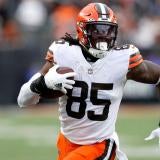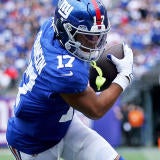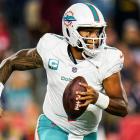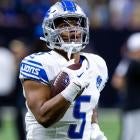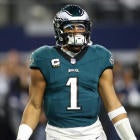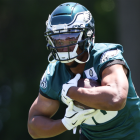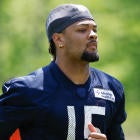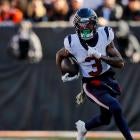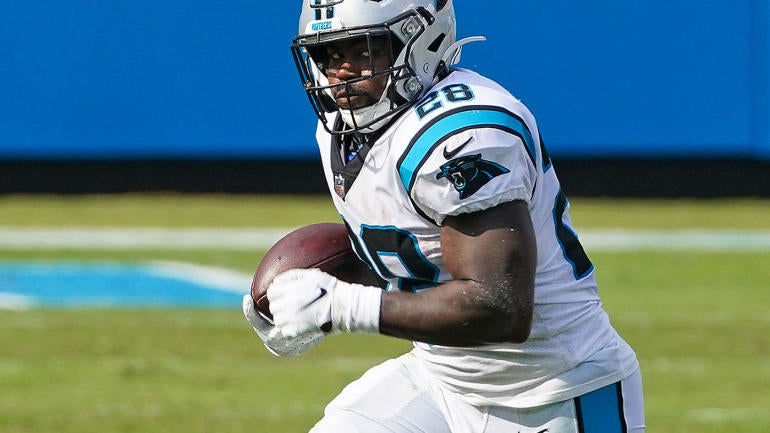
Every year the argument we hear for pushing running backs into the first two rounds of PPR Fantasy drafts is positional scarcity. And for the first half of the first round, there's very little debate. There are only a handful of workhorse backs who have proven their excellence. They needed to be drafted before anyone else. As long as they don't get hurt, they provide you a major advantage.
This year, it's possible you could extend that argument all the way to No. 10 at running back. After that things get very murky. Current NFC ADP since May 1 would tell you that 17 of the first 28 picks should be running backs, including backs like Antonio Gibson, J.K. Dobbins, and Clyde Edwards-Helaire. Whether that's true or not may hinge largely on the production of Myles Gaskin and Mike Davis.
If there are only 17-18 running backs capable of producing RB2 numbers, ADP would seem pretty reasonable. Positional scarcity is exactly what I use to justify Travis Kelce in Round 1, after all. But Gaskin and Davis are both available in Round 5 or later. So is Kareem Hunt. And Chris Carson is there in Round 4, and he was better than Gibson, Dobbins and Edwards-Helaire last year.
Of course, the argument with those younger backs is that they are going to improve. The argument I'd make for Gaskin and Davis is that they don't have to.
- We react to all of the latest news and tell you where Raheem Mostert and Dak Prescott will be ranked on the Fantasy Football Today in 5 podcast. Listen below and follow at Apple, Spotify or wherever you get your podcasts:
In 2020 Gaskin was RB12 on a per-game basis. While much of the argument for the second-year backs is built around their best six or seven game stretch, Gaskin tops most of them in that area as well. He had a seven-game stretch where he averaged 106 yards per game. Bolstering his case is the fact that the Dolphins only added Malcolm Brown and Gerrid Doaks as competition. Salvon Ahmed is still there, and Gaskin doesn't have the pedigree to guarantee a starting role, but if Gaskin is as good as he was last year, there's no reason to think he won't be a high-end No. 2 running back.
Davis' case is similarly enticing. In 12 games without Christian McCaffrey, Davis averaged 15.4 PPR Fantasy points per game, which would have made him RB14, right behind Gaskin and Carson. He was the lone main addition to the Falcons running back stable as the team passed multiple times on running backs in the draft and free agency. His new head coach, Arthur Smith, orchestrated the last two monster seasons for Derrick Henry in Tennessee. While you shouldn't expect anything like that, you should expect the Falcons to be better at running the ball than they were last year.
Looking at the projections below you'll see I have Davis and Gaskin in the same tier, book-ending the second-year trio I referenced above. I don't have a problem with anyone who prefers the younger backs, but there is not much justification for them going two to three rounds higher, as they currently are. If Davis and Gaskin can come close to what they did last season, there is no reason to panic at running back late in the second round or early in the third. And this position may not be so thin after all.

Fantasy Football Today Newsletter
Know What Your Friends Don't
Get tips, advice and news to win your league - all from the FFT podcast team.
Thanks for signing up!
Keep an eye on your inbox.
Sorry!
There was an error processing your subscription.
A few other notes before we get to the projections:
- The running backs in San Francisco, Arizona, Tampa Bay, New York (Jets), and Buffalo all have more upside than where they're projected. But they look like the worst of committees, and that's just not going to play very well in projections.
- I'm still projecting D'Andre Swift without Todd Gurley, and I understand anyone who would compare my projection of Swift with the backs I talked about above. The difference for me is that I believe more in Swift's talent, and Anthony Lynn. Lynn's offenses are always among the league leaders in running back touches, so his committees are more palatable.
- Once you get outside the top 30 running backs, the rankings and projections diverge more than any other position. This is one position you don't want to draft off projections late.
- There are rankings for both non-PPR and PPR on the left, but don't miss the .5 PPR projections to the right.


